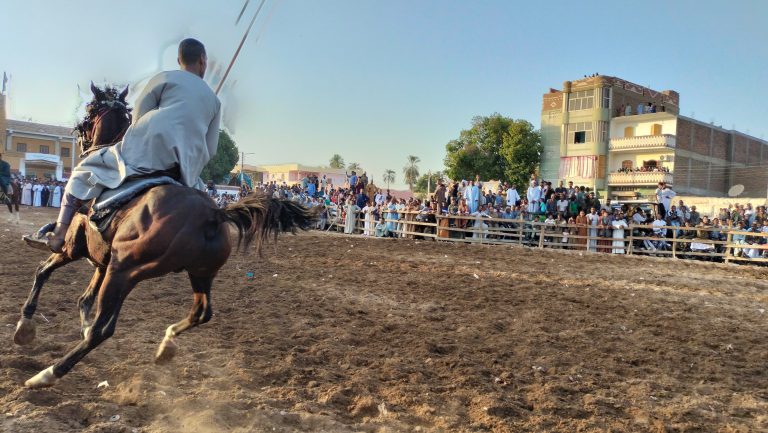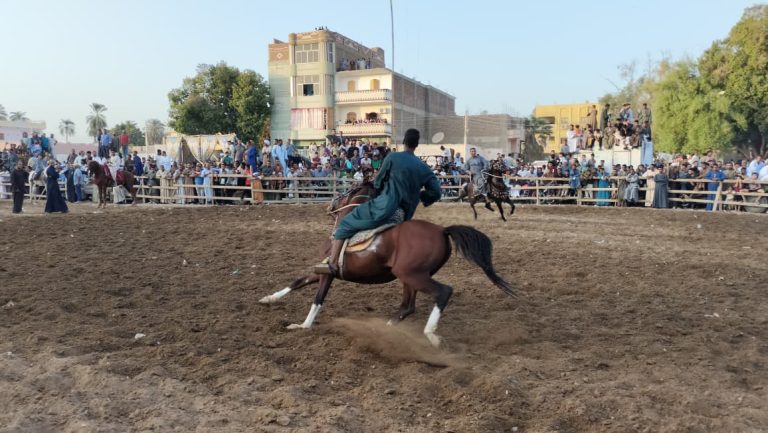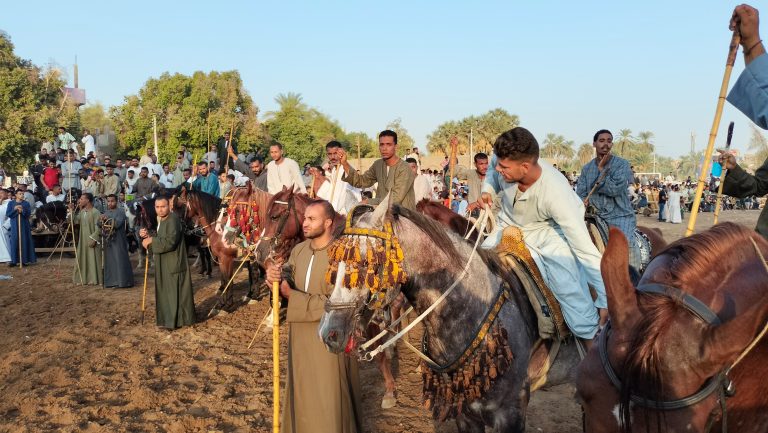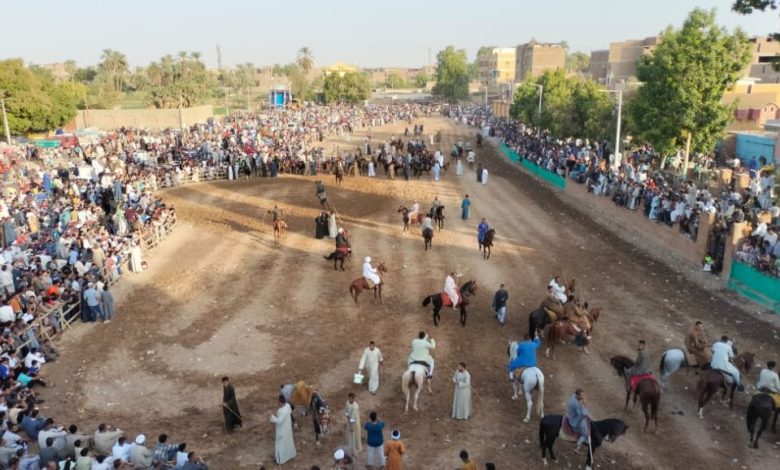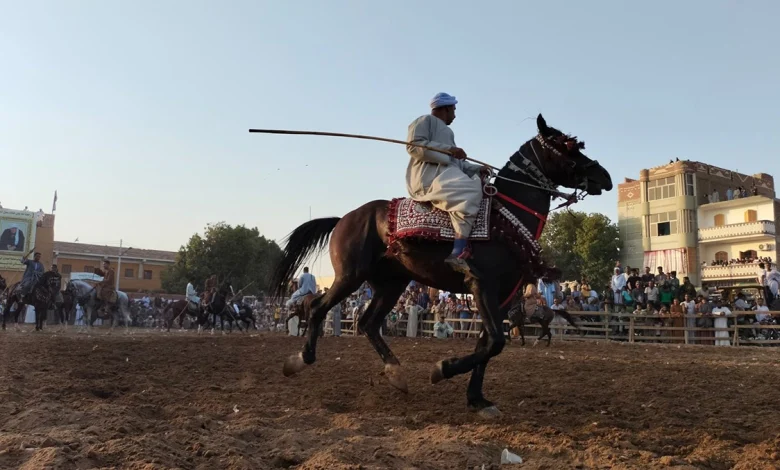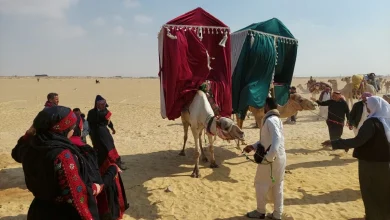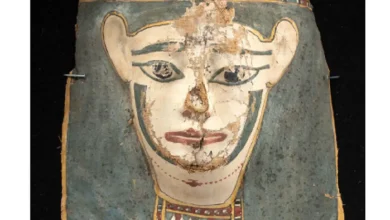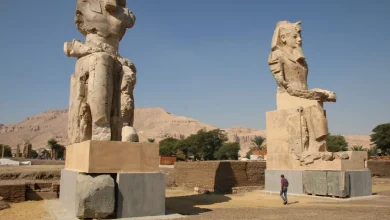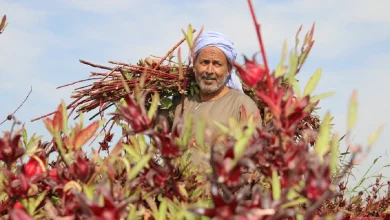Mermah is a fencing on horse competition and for over 150 years tournaments take place in celebration of the Prophet Mohamed’s birthday in Luxor
The “Marmah” events continue during the celebrations of the Prophet’s Birthday in the village of Manshaat Al-Amari, affiliated with the Luxor Center, where the celebrations begin with the first day of Rabi’ Al-Awwal and continue for 12 consecutive Leda days,
until the night of the Prophet’s birthday, in a popular tradition that has become one of the most prominent features of cultural and religious life in Upper Egypt.The oldest marah in LuxorThe Marah of Manshaat al-Amari is the oldest and largest marah held in the governorate of Luxor. Its origins date back nearly 150 years, when it was launched by the elders of the Amari family, and it has continued uninterrupted ever since. It has become an annual gathering place for dozens of horsemen and riders from various centers in the governorate. Participants also come from the governorates of Qena, Aswan, and Sohag, and even some centers in the coastal governorates.
The site of the Marmah, a large square on the outskirts of the village, is transformed into a carnival arena that combines equestrianism and folk rituals. Local flute and drum circles spread out, and cafes and tents are set up to welcome guests, in a scene reminiscent of major folk festivals.
An authentic Arab tradition
Mohamed Adel Al-Amari, one of the horsemen and organizers of the celebrations, says that Al-Marmaah is a direct extension of the Arab heritage in the Arabian Peninsula. It is a practice associated with horsemanship and skill in riding horses. He explains: “Al-Marmah is not a horse race, as some people imagine. Rather, it is a display of the rider’s skill in controlling the horse, his ability to charge and retreat, and his ability to catch the spear-like lance. It is an art derived from ancient wars, reflecting the spirit of Arab horsemanship.”
He adds that in the past, the Prophet’s birthday was celebrated for only three days in Al-Amari. However, with the passage of time and the increase in the number of participants, it has been extended to 12 Leda, interspersed with daily equestrian events, woodcutting, and folk music.
Sections of Al-Marmaah and its arts
Al-Marmaah is divided into three main sections, according to Al-Amari:
1- Al-Ramah: a display of the rider’s skills in controlling the horse, the whip, and the reins.
2- Al-Mashalah and Al-Sabiah: similar to ancient military training, in which the rider demonstrates his ability to maneuver.
3- Al-Taktiq: This section is most closely associated with the artistic aspect. In it, the horseman displays his skill in “horse dancing” to the rhythms of the local flute, which symbolizes the drums of war. It excites both the audience and the horses.
Al-Amari points out that these arts are no longer just entertainment, but have become a symbol of identity and pride in heritage. He notes that many young people inherit equestrian skills from their fathers and grandfathers. They learn from an early age how to ride and handle horses.
Participation is an annual ritual
Abdullah Sultan, one of the participating horsemen, says that he has been attending the Marmah annually since childhood, considering participation in it an indispensable ritual. He adds, “For us, the Marmah is not just a show or a festival. It is a spiritual experience and a sense of belonging. We celebrate the Prophet’s birthday in our own way, honoring the Prophet and reviving the heritage of our ancestors.
Sultan emphasizes that the horsemen wait for these days all year long. Each of them takes care to prepare their horses in the best possible way and train them in the necessary movements before the start of the Marmah.
Cultural and popular roots
Mohamed Hashmat Al-Amari, one of the organizers, explains that the marah is one of the oldest celebrations of the Prophet’s birthday in Luxor. It is even considered one of the pillars of cultural life in Al-Amari.
He says, “The form of celebrations may change in other places. But here, the marah is the center. People come from everywhere to watch and participate. It is a collective celebration that connects people and promotes social solidarity.”
He adds that families are responsible for organizing the reception and hospitality. Food and drinks are served to visitors, turning the marmah into a family occasion par excellence, where religious spirit intertwines with popular joy.
Researchers’ perspective
Mohammed Rashid, a researcher specializing in folk heritage, points out that the marmah is a living example of what folklorists call “composite celebrations.” It combines religious rituals (the Prophet’s birthday) and folk arts (flute playing, woodcutting, horse dancing), along with economic and social dimensions.
Rashid adds: “Al-Marmaah is not just an entertainment show, but a collective memory. When people gather in one place, they reproduce values such as courage, generosity, and loyalty. It is a comprehensive symbolic discourse that brings to mind the idea of heroism and chivalry, which has historically been associated with Sufism and the celebration of the Prophet.”
Rashid points out that the fact that Al-Marmaah has continued uninterrupted for 150 years reflects the strength of popular culture in Luxor and its ability to preserve its rituals despite social and economic changes.
A complete festive scene
Al-Marmaah is not limited to equestrian shows, but is also a center for other events such as stick fighting, which attracts a wide audience. Young people show off their skills in stick fighting to the tune of the flute.
There are also simple amusement parks for children, popular cafes, and tents selling food and drinks. This makes the place a complete festive arena. During these days, the village becomes a destination for visitors from outside the village, who come specifically to watch the shows and enjoy the atmosphere.
A heritage in need of documentation
Despite the great importance of marmah, Rashid believes that this heritage needs to be further documented and studied so that it is not confined to oral memory. It could become rich material for research projects and documentaries that highlight its various dimensions.
He continues: “If we want to preserve Upper Egypt’s cultural identity, we must pay attention to such rituals. Marmah is not just entertainment, but a living record of a long history of Arab and Islamic traditions that have blended with the Egyptian environment.”
The story continues
Thus, Marmah Manshaat Al-Amari remains a prominent feature of the celebrations of the Prophet’s birthday in Luxor. It combines horsemanship, spirituality, and popular joy, representing a link between the past and the present. As the locals continue to revive it year after year, Marmah proves that popular culture is capable of survival and renewal.

